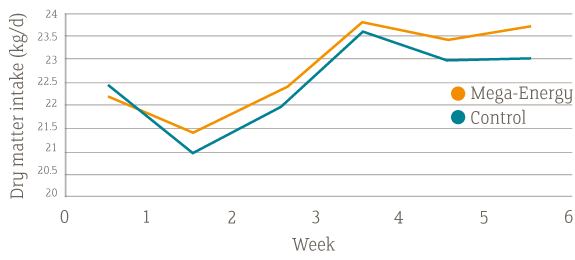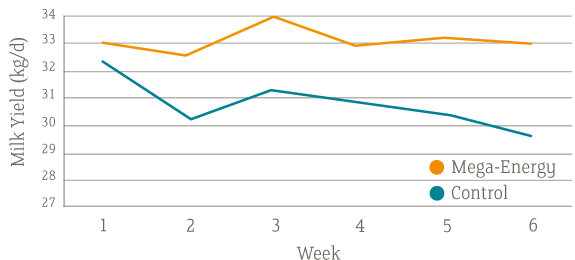Mega-Energy
The response to supplementation of lactating dairy cow diets with Mega-Energy was evaluated in a study at Schothorst Feed Research, the Netherlands.
Twenty mid-lactation dairy cows were offered either a control concentrate, or the control concentrate to which 5% Mega-Energy had been incorporated, for a six-week treatment period. Concentrates were offered in addition to the basal diet according to production in the period preceding the study, resulting in an average intake of 375 g of Mega-Energy/cow/d.
As presented in Table 1, cows offered the Mega-Energy supplement produced an additional 2.1 kg milk/d at similar levels of DM intake. The higher milk volume also resulted in higher milk fat and protein yields (kg/d), despite similar (fat) or slightly lower (protein) concentrations, and also improved feed efficiency assessed as kg milk/kg DM intake. Importantly, the extra milk output was not at the expense of body tissue as body condition score was similar between the groups.
Table 1 Milk production of cows offered Mega-Energy
| Control | Mega-Energy | Sig. | |
| DM intake (kg/d) | 22.5 | 22.8 | NS |
| Milk yield (kg/d) | 30.0 | 32.1 | * |
| Milk fat (%) | 4.39 | 4.41 | NS |
| Milk fat yield (kg/d) | 1.31 | 1.41 | * |
| Milk protein (%) | 3.60 | 3.51 | * |
| Milk protein yield (kg/d) | 1.08 | 1.12 | * |
| Feed efficiency (kg/kg) | 1.33 | 1.41 | * |
| Body condition score | 2.6 | 2.6 | NS |
Figure 1 presents the pattern of DM intake assessed through each week of the study and particularly highlights the fall off in DM intake in week 2 of the study, reflecting a reported period of heat stress.

Figure 1 Dry matter intake recorded across the study
Cows offered the Mega-Energy supplement tended to consume marginally more DM, including through the period of heat stress, resulting in considerably higher milk production through the heat stress period compared to cows offered the control ration (Figure 2).

Figure 2 Milk yield recorded across the study
These data indicate that supplementation of diets with Mega-Energy can effectively lift milk yield and milk solids and prove beneficial in maintaining energy intake and milk production through periods of heat stress.